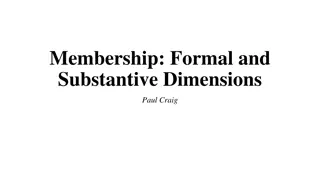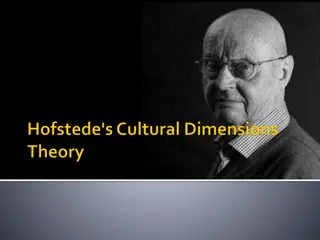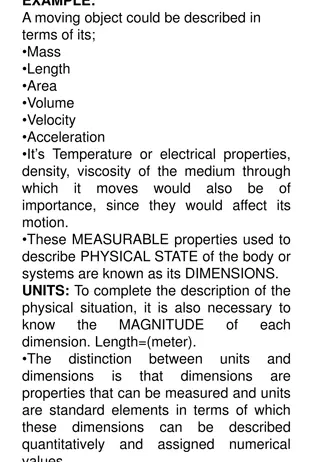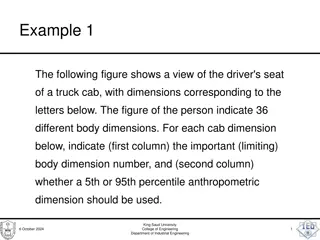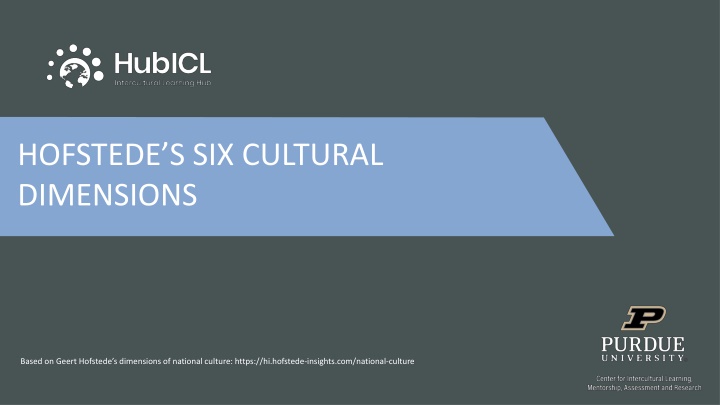
Understanding Hofstede's Six Cultural Dimensions
Explore Hofstede's six cultural dimensions - Power Distance, Masculinity vs Femininity, Uncertainty Avoidance, Individualism vs Collectivism, Long-Term vs Short-Term Orientation, and Indulgence vs Restraint. Gain insights into how societies handle inequalities, competitiveness, ambiguity, self-image, time orientation, and desires. Consider your own cultural values and behaviors in different societal contexts.
Uploaded on | 0 Views
Download Presentation

Please find below an Image/Link to download the presentation.
The content on the website is provided AS IS for your information and personal use only. It may not be sold, licensed, or shared on other websites without obtaining consent from the author. If you encounter any issues during the download, it is possible that the publisher has removed the file from their server.
You are allowed to download the files provided on this website for personal or commercial use, subject to the condition that they are used lawfully. All files are the property of their respective owners.
The content on the website is provided AS IS for your information and personal use only. It may not be sold, licensed, or shared on other websites without obtaining consent from the author.
E N D
Presentation Transcript
HOFSTEDES SIX CULTURAL DIMENSIONS Based on Geert Hofstede s dimensions of national culture: https://hi.hofstede-insights.com/national-culture
HOFSTEDES SIX CULTURAL DIMENSIONS As we go through the continua on each slide, take some time to consider where you might fall o. Consider your cultural values and behaviors related to the society in which you live, or in which you grew up. You can choose to think of society on a national, regional, or local level. Note: Where you fall on the continua is not necessarily static. You may fall at different points depending on the context and situation. For example, you might prefer consensus in your personal life, but your work environment might be more competitive.
POWER DISTANCE The fundamental issue here is how society handles inequalities among people. More comfortable with equal distribution of power. More comfortable with hierarchy. Large Power Distance Small Power Distance
MASCULINITY VS. FEMININITY The fundamental issue is whether society is more competitive or more consensus oriented. Consensus is valued. Competition is valued. Traditionally Masculine Traditionally Feminine
UNCERTAINTY AVOIDANCE The fundamental issue here is how a society deals with the fact that the future can never be known: should we try to control the future or just let it happen? Ambiguity is welcomed. Uncomfortable with ambiguity. Weak Strong
INDIVIDUALISM VS. COLLECTIVISM The fundamental issue is whether people s self-image is defined in terms of I or we. The community is emphasized over the individual. The individual is emphasized over community. Individualism Collectivism
LONG-TERM VS. SHORT-TERM ORIENTATION The fundamental issue is whether society is more focused on future rewards or quick results. Wide focus that includes past, present, and future. More focused on the present. Long-Term Orientation Short-Term Orientation
INDULGENCE VS. RESTRAINT The fundamental issue here is the extent to which people try to control their desires and impulses. Restrain your desires and stick to social norms. Indulge your desires and have fun. Indulgence Restraint
DEBRIEF QUESTIONS Where would you place yourself on these various continua? Why? Do you people in your cultural group generally agree with you? How much variation exists within your cultural group? Did you identify any instances where it might depend on the situation or context? What stereotypes or preconceived notions do you often have about people on different points on these continua? What stereotypes or preconceived notions might people have about you depending on where you fall on these continua? What are some strategies you might use to better understand or relate to people who fall on different points than you?







